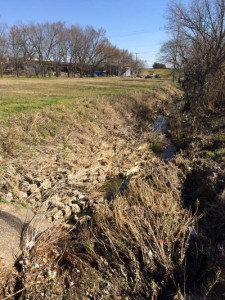Oops! I made a couple of mistakes in a recent blog post. Sometimes I do that with oral history. It wasn’t critical; I just didn’t ask enough questions. If you recall I wrote about the Gumbo Pits found in Hunt and Collin Counties.
The purpose of the gumbo pits was to turn our black soil into rocks, a commodity not found naturally in the Blackland Prairie. But somehow I was a little too creative when describing the process. Reading a wonderful article on the Collin County Historical Commission website (http://www.collincountytx.gov/), I learned more about the physical phenomenon of changing dirt to rocks.
In Collin County, the Cotton Belt Railroad dug long trenches with steam shovels instead of by hand in the 1880s. I suspect both methods were used, especially during the 1930s. The Cotton Belt laid crossties in the trenches, then a layer of coal, and finally a layer of dirt clods were place on the crossties. The area was watered down to prevent the coals from burning too fast. Once the fire died and the trench cooled down, the clods that were now rocks were raked out, cooled and used as ballast for the tracks.
My Hunt County sources noted that crossties were not wasted. Large trees were plentiful along the small creeks and streams throughout the county. Those were the fuel used to convert dirt to rocks. During the Great Depression, dynamite was used to blast out the pits.
The same principles were used until the 1880s in other parts of Hunt County to make bricks. One of the brickyards was located between Ardis Heights and Puddin Hill. The bricks were a light red-orange, not perfectly formed, and a few are still in existence today. In later years the bricks were covered with a plaster to appear more appealing to the eye.
A second phenomenon I encountered in my paper for the New Deal Conference in Beaumont was “rip-rap.” The Greenville Garden Club received an $1100 Public Works Administration (PWA) grant to clean up Town Branch. By the early 20th century, the small creek just south of the GEUS Service Building was a foul smelling, mosquito breeding water hole. Cleaned out by the City Street Department repeatedly in the teens, Town Branch was a mess again in a few weeks.
So the good ladies of the Garden Club, led by president Gertrude Horton, applied for the grant. With the money they decided to riprap the creek. That meant large rocks were moved to the creek bed, laid in a manner to reduce stagnant water, and hopefully rid the waterway of sewer and weeds. The rocks came from debris left after the construction of the present day courthouse in 1928 and other building sites. Prisoners in the county jail volunteered for the project in order to work out fines. A total of $500 was spent on the project; the remaining $600 returned.
The Town Branch project went from Wesley Street to Johnson Street. Countless other projects put the unemployed to work for a short time throughout Greenville and Hunt County during the Great Depression. While the intent was creating jobs, what really happened was community improvement in the form of public works.

